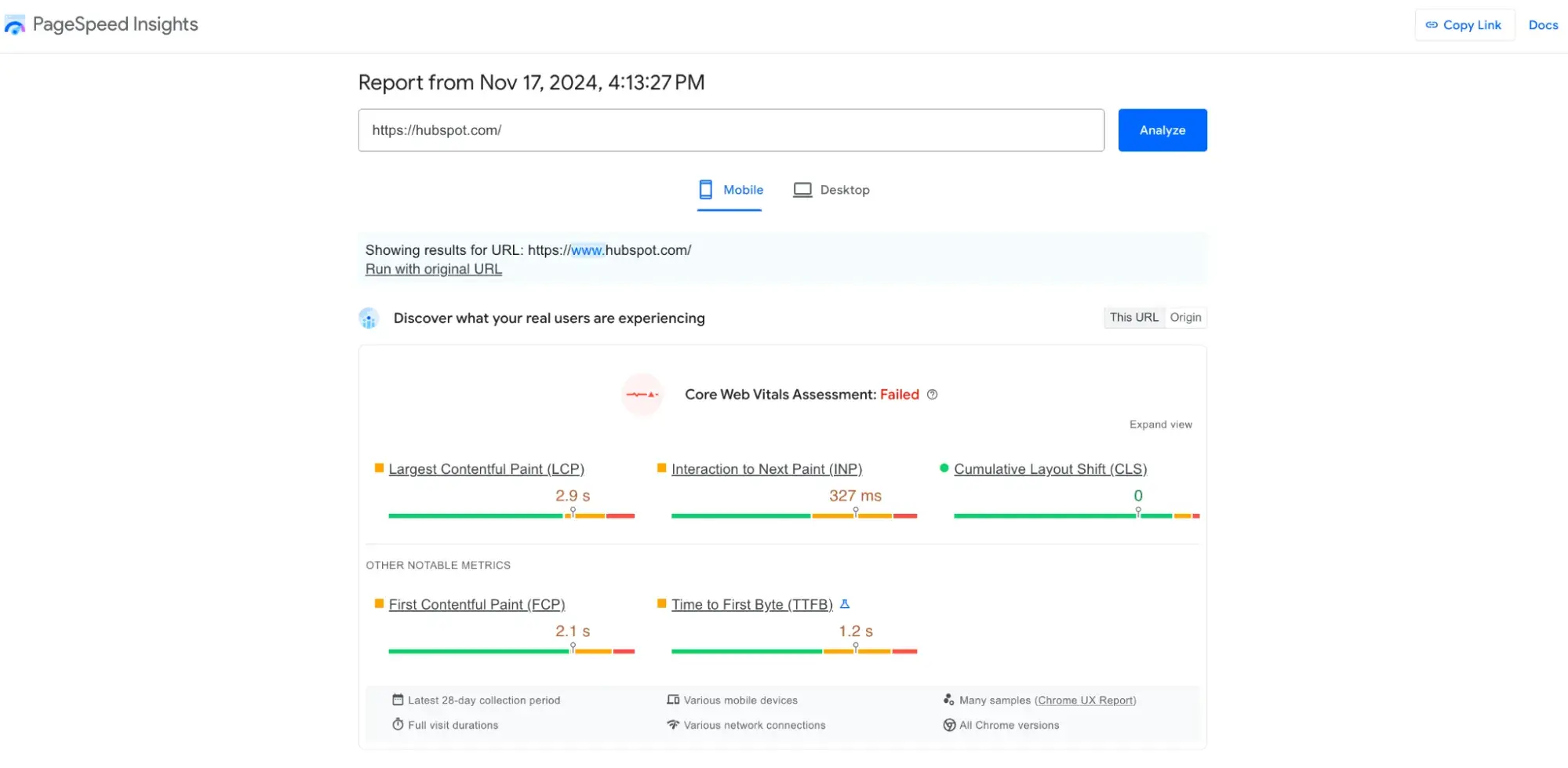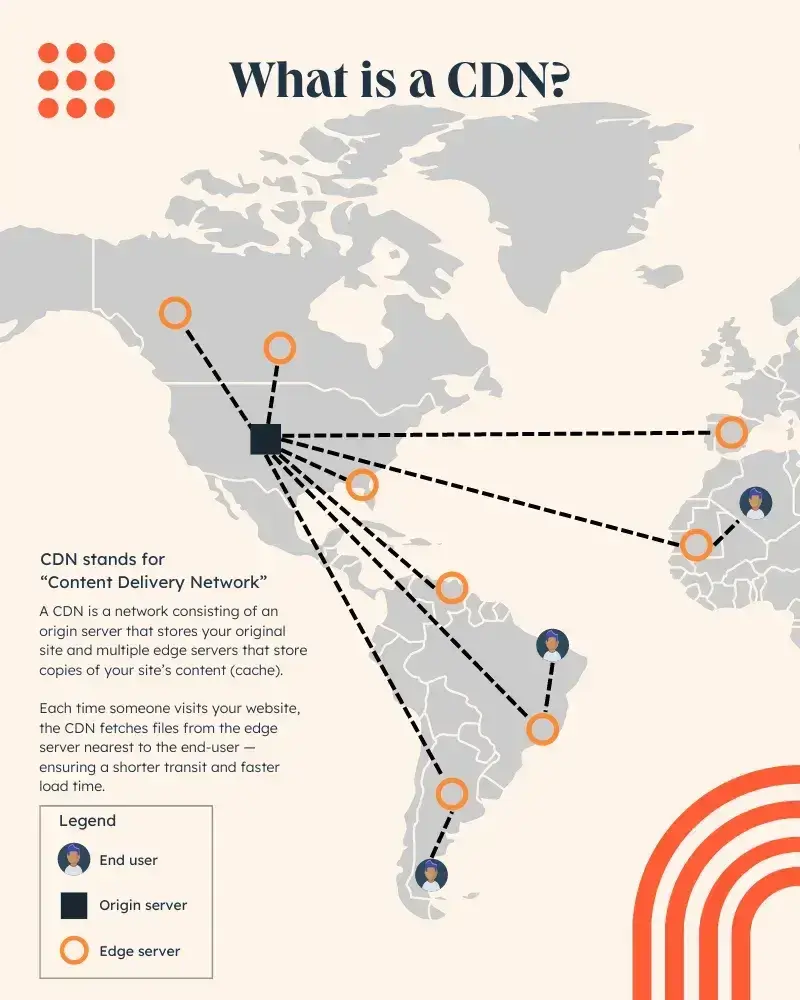But first, we have to dive into what TTFB is anyway, why it becomes slow, and why it‘s crucial. In this post, I’ll answer all of those questions and provide tangible steps you can take to reduce server response times.
Table of Contents
- What is TTFB?
- Why is TTFB important?
- What causes slow TTFB?
- How to Reduce Server Response Times (TTFB)
- WordPress TTFB Tips
What is TTFB?
TTFB stands for Time to First Byte. It’s a key metric that reveals how long it takes for my website to start rendering after someone visits. It’s essentially a measure of how responsive my server is. I’ve realized just how much that responsiveness impacts my site’s overall performance and success.
Server response times refer to the waiting period for an initial response, so some people use this term and “page load time” interchangeably. I think these two phrases are connected, but they're not synonymous. While TTFB focuses on the time for a site to respond, page load time is the average time it takes for a page to show up on your screen. (Page load time, however, is also important — here are some statistics that show this.)
There are three variables that impact my website's Time to First Byte. They include:
- Connection time — how long it takes for an HTTP request to be sent.
- Server processing time — how long it takes for my server to process a request.
- Response time — how long it takes for my server to reply with the first byte to the web browser.
My website's Time to First Byte starts with an HTTP request. The length of time it takes for my server to receive the request varies, depending on how long it takes for a DNS lookup, the server distance, how fast the visitor's network is, and interruptions in the connection.
After the server receives the request, it will process and generate a response. Then, the server will send the response to the site visitor. How fast this occurs depends on the server and user network speed, so it's multi-pronged.
How to Measure TTFB
To figure out if I need to reduce my website’s TTFB, the first step is measuring it. I’ve found several effective ways to check this.
One option is using a third-party website, which not only measures server response times but also provides valuable insights into overall site performance. I prefer to use Google's PageSpeed Insight tool. Other good software I have found helpful for measuring TTFP are GTmetrix and Pingdom Tools.

Another method I’ve used is checking the Network tab in Chrome’s Console — it’s a quick way to get detailed TTFB data. As a last method, I use the browser developer tool. By opening my website on a browser and going to the Network tab of the developer tool, I can see how long it takes for the site to respond.
Why is TTFB important?
The primary reason TTFB is essential is that it makes significant contributions to my overall page speed. Remember, slow load times lead to a higher bounce rate.
In addition, the faster a page loads, the more pleasant the user experience is for site visitors. Therefore, as someone who prioritizes my visitors, I work tirelessly to ensure my server response time is optimized.
TTFB not only affects user experience, but it also impacts Core Web Vitals scores, so by working to reduce server response times, I might see a positive impact on that, too.
As I see it, improving my website’s time to first byte benefits multiple aspects of its performance while creating a more enjoyable experience for visitors. To me, that’s a major win!
What is a good TTFB?
According to Google, my Time to First Byte should be less than 600 ms. If my TTFB exceeds this, it will result in a failed audit, which I want to avoid. The best practice is to keep my server response time under 200 ms.
Let's say I run website analytics and notice that my site has a slower TTFB. That indicates that there might be a hiccup along the way. By figuring out the problem and implementing a fix, I can rest assured that my site visitors will have a manageable experience, also reducing the likelihood of them bouncing.
Let's say I run website analytics and notice that my site has a slower response time. This indicates there might be a bottleneck somewhere. By identifying the issue and implementing a fix, I can ensure that visitors to my site have a smoother experience, reducing the likelihood of them bouncing.
What causes slow TTFB?
So, what's responsible for the slow TTFB? In the past, several factors have contributed to my website experiencing a bottleneck. Here’s what I’ve encountered:
- Bad network connection to the server. Having a poor network connection often leads me to have a slow TTFB. While this isn‘t a problem I can solve for my site visitor, it’s definitely a leading cause of a slow TTFB.
- High website traffic. When my server receives too many simultaneous requests that it isn't prepared for, it leads to a slow response time for each user.
- Poor database connection. I’ve seen instances where slow database queries or a poorly optimized database connection increase server response time. If my site relies on dynamic content pulled from a database, inefficiencies or congestion in the database can cause delays in processing requests.
- Server Configuration Issues. Sometimes, I’ve encountered server configuration issues that impact performance. Improperly set up servers or outdated software can prevent them from responding efficiently. Ensuring that my server is correctly optimized can make a significant difference in TTFB.
- Poor DNS response time. Sometimes the DNS server takes too long to resolve the domain name into an IP address; this also impacts the server response time of my site.
Pro tip: When my TTFB is high, I analyze the root cause. Whether it’s slow server performance, database inefficiencies, or unoptimized code, identifying the exact bottleneck helps me address it directly.
How to Reduce Server Response Times (TTFB)
Now that I know what causes slow TTFB, let's dive into how to reduce it. Here are six tangible tactics I use that give my server response time a well-deserved boost.
Use caching.
I make sure to use page and object caching wherever possible. This allows me to store pre-rendered content so the server doesn’t need to regenerate it for every request. By implementing caching, I decreased my site's TTFB. This is because no cache can lead to higher overall load times.
Always keep in mind that some web hosting providers already have built-in caching tools, so make sure to utilize those tools.
Reduce the number of page redirects.
It's no secret that the fewer page redirects, the better. If I have a lot of page redirects, that means my browser makes more HTTP requests. And that can result in an increased server response time, which my site visitors won't enjoy.
Be mindful of the web host.
Choosing the right web hosting provider can be tricky, but paying attention to hosting providers and selecting the right one is totally worth it. Why? I came to understand that a website hosting provider greatly impacts various factors of my website, including server response time. The faster my host is, the better.
Additionally, I need to be mindful of where the web hosting provider's servers are. For instance, if most of my site visitors originate from the United States, it makes sense to host my site within the U.S. That’s one of the reasons I choose HubSpot.
Pro tip: To determine if my hosting provider is the problem, I sometimes test my site on alternative hosting platforms. Comparing TTFB results across providers can show me if an upgrade is necessary. So far, an upgrade hasn't been necessary.
Keep everything up-to-date.
Anything outdated is the enemy of fast server response times. So, I fine-tune my server’s software, like ensuring I’m using an optimized version of PHP or configuring Apache and Nginx for better performance. I also made the switch to HTTP/2 or HTTP/3 for faster data transfer.
Consider if a content delivery network is suitable for the website.
To serve content faster to visitors, especially those far from my server’s physical location, I rely on a CDN. It caches my site’s static assets and delivers them from servers closer to the users, cutting down on load times.

A content delivery network differs from traditional website hosting because it doesn‘t rely on just one server but an international network. Therefore, regardless of where my visitors are located, they’ll enjoy a pleasant user experience.
Invest in DNS.
I‘ll usually have to upgrade if I want premium DNS, but trust me, it’s worth it! Basic DNS servers may not render requests quickly enough, which could spell trouble for my DNS lookup times and, therefore, TTFB.
By investing in DNS, my queries will be answered with low latency. This is possible thanks to an international network of DNS servers, and yes, it could reduce server response times.
WordPress TTFB Tips
It can be tricky to increase WordPress TTFB, but it's possible. Here are some of the best strategies I recommend to use for WordPress TTFB optimization.
Use plugins wisely.
Remember how I mentioned earlier that using caching helps reduce server response time? The good news is that many caching plugins are available for WordPress sites. Using these plugins allows me to speed up my time to first byte. In my opinion, fewer plugins reduce the load on my server, which helps reduce server response times. I regularly review my installed plugins and deactivate or delete ones I don’t need.
Consider managed hosting.
Because hosting is a significant reason why websites struggle with TTFB, switching to a managed hosting provider for my WordPress site would be beneficial. This is because many managed hosting providers won't share resources across sites, resulting in a much faster site on my end.
Consider optimizing the database.
The database could be another contributing factor to a less-than-favorable TTFB. Over time, I noticed my database gets cluttered with unnecessary data like revisions and spam comments. Therefore, by running a cleanup and optimizing my database, I could see significant improvements in my server response times.
Using a plugin like WP-Optimize, I clean up and optimize my database for faster response times.
Use a lightweight theme.
I’ve learned that heavy themes can slow down my server’s response time. By switching to a lightweight theme like Astra or GeneratePress, I keep my site’s performance sharp without compromising design.
Reduce Time to First Byte today.
When I’m scrolling online, I need information to load fast. I’m not the only one. The Internet Age is defined by immediate gratification. Your visitors want to get on your site as quickly as possible. Take too long and they click away.
Understanding my site’s TTFB allows me to optimize for speed. So, start testing your site and fixing the hiccups that slow you down. Your audience will thank you.
Editor's note: This post was originally published in December 2022 and has been updated for comprehensiveness.
Website Performance








![7 Site Performance Challenges That Will Hold Businesses Back [Data + Expert Predictions]](https://53.fs1.hubspotusercontent-na1.net/hubfs/53/how-to-improve-lcp-1-20250121-126295.webp)


![19 Website Speed Optimization Strategies for 2024 [New Data]](https://53.fs1.hubspotusercontent-na1.net/hubfs/53/how-to-optimize-website-speed-1-20241203-1468927.webp)
